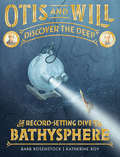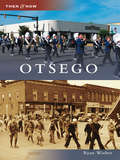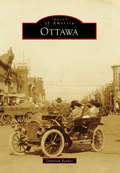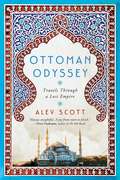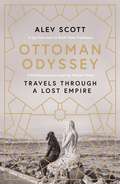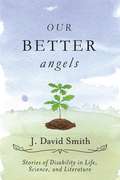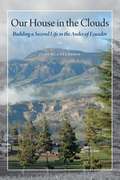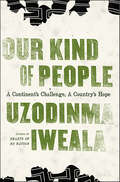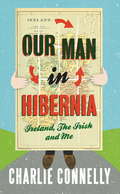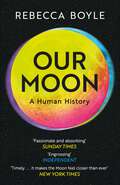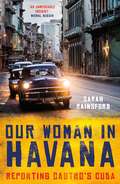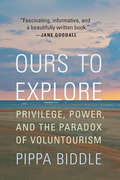- Table View
- List View
Other Rivers: A Chinese Education
by Peter HesslerAn intimate and revelatory account of two generations of students in China&’s heartland, by an author who has observed the country&’s tumultuous changes over the past quarter centuryMore than two decades after teaching English during the early part of China&’s economic boom, an experience chronicled in his book River Town, Peter Hessler returned to Sichuan Province to instruct students from the next generation. At the same time, Hessler and his wife enrolled their twin daughters in a local state-run elementary school, where they were the only Westerners. Over the years, Hessler had kept in close contact with many of the people he had taught in the 1990s. By reconnecting with these individuals—members of China&’s &“Reform generation,&” now in their forties—while teaching current undergrads, Hessler gained a unique perspective on China&’s incredible transformation.In 1996, when Hessler arrived in China, almost all of the people in his classroom were first-generation college students. They typically came from large rural families, and their parents, subsistence farmers, could offer little guidance as their children entered a brand-new world. By 2019, when Hessler arrived at Sichuan University, he found a very different China, as well as a new kind of student—an only child whose schooling was the object of intense focus from a much more ambitious cohort of parents. At Sichuan University, many young people had a sense of irony about the regime but mostly navigated its restrictions with equanimity, embracing the opportunities of China&’s rise. But the pressures of extreme competition at scale can be grueling, even for much younger children—including Hessler&’s own daughters, who gave him an intimate view into the experience at their local school.In Peter Hessler&’s hands, China&’s education system is the perfect vehicle for examining the country&’s past, present, and future, and what we can learn from it, for good and ill. At a time when anti-Chinese rhetoric in America has grown blunt and ugly, Other Rivers is a tremendous, essential gift, a work of enormous empathy that rejects cheap stereotypes and shows us China from the inside out and the bottom up. As both a window onto China and a mirror onto America, Other Rivers is a classic from a master of the form.
Otherworldly Antarctica: Ice, Rock, and Wind at the Polar Extreme
by Edmund StumpWith stunning original photographs, an Antarctic scientist and explorer takes us to one of the most sublime, remote, and pristine regions on the planet. The interior of Antarctica is an utterly pristine wilderness, a desolate landscape of ice, wind, and rock; a landscape so unfamiliar as to seem of another world. This place has been known to only a handful of early explorers and the few scientists fortunate enough to have worked there. Edmund Stump is one of the lucky few. Having climbed, photographed, and studied more of the continent-spanning Transantarctic Mountains than any other person on Earth, this geologist, writer, and photographer is uniquely suited to share these alien sights. With stories of Stump’s forty years of journeys and science, Otherworldly Antarctica contains 130 original color photographs, complemented by watercolors and sketches by artist Marlene Hill Donnelly. Over three chapters—on the ice, the rock, and the wind—we meet snowy paths first followed during Antarctica’s Heroic Age, climb the central spire of the Organ Pipe Peaks, peer into the crater of the volcanic Mount Erebus, and traverse Liv Glacier on snowmobile, while avoiding fatal falls into the blue interiors of hidden crevasses. Along the way, we see the beauty of granite, marble, and ice-cored moraines, meltwater ponds, lenticular clouds, icebergs, and glaciers. Many of Stump’s breathtaking images are aerial shots taken from the planes and helicopters that brought him to the interior. More were shot from vantages gained by climbing the mountains he studied. Some were taken from the summits of peaks. Many are of places no one had set foot before—or has since. All seem both permanent and precarious, connecting this otherworld to our fragile own.
Otis and Will Discover the Deep: The Record-Setting Dive of the Bathysphere
by Katherine Roy Barb RosenstockThe suspenseful, little-known true story of two determined pioneers who made the first dive into the deep ocean.On June 6, 1930, engineer Otis Barton and explorer Will Beebe dove into the ocean inside a hollow metal ball of their own invention called the Bathysphere.They knew dozens of things might go wrong. A tiny leak could shoot pressurized water straight through the men like bullets! A single spark could cause their oxygen tanks to explode! No one had ever dived lower than a few hundred feet...and come back. But Otis and Will were determined to become the first people to see what the deep ocean looks like.This suspenseful story from acclaimed author Barb Rosenstock with mesmerizing watercolors by award-winning artist Katherine Roy will put you right in the middle of the spine-tingling, record-setting journey down, down into the deep.
Otsego
by Ryan WieberOtsego has a rich and storied past as one of the earliest settlements in southwest Michigan. Founded in 1831, its character has been shaped by a history filled with agriculture, tourism, fascinating people, and remarkable commerce--particularly the manufacturing of paper. Otsego has seen the rise and fall and recent rebirth of the local papermaking industry, and it is now poised to progress through the 21st century with a renewed sense of vigor.
Otsego and Plainwell (Images of America)
by Ryan Wieber Sandy StammIn 1831, Samuel Foster and his family built a log house near the rapids of the Kalamazoo River at what is now downtown Otsego. Soon others interested in utilizing the power afforded by the river set up sawmills and grain mills for newly arriving settlers, and the beginnings of a town quickly took shape. In the 1900s, Otsego became synonymous with the paper industry, and for a while, seven paper mills were in operation at the same time. Plainwell, originally called Plainfield and the Junction, situated itself at the crossroads of the old plank roads that led to Grand Rapids, Kalamazoo, and Allegan. Here too, the paper industry played an important part in the growth of Plainwell. Since the downtown area is completely surrounded by the Kalamazoo River and a millrace, it is now referred to as the Island City." Plainwell's historic heritage is evident today through its quaint downtown architecture and beautifully restored neighborhood homes. Otsego and Plainwell have grown up close to each other and share their stories, families, and traditions."
Ottawa
by Deborah BarkerOttawa was founded in 1864. Located in the Marais des Cygnes River Valley, the area's rich soil and lush grass made it well suited for growing crops and pasturing livestock. The community's first cultural center was Ottawa University, which was chartered in 1865 and built on land exchanged by the Ottawa Indians for the promise of an education for their children. Two railroads later arrived, the Lawrence, Leavenworth & Galveston in 1868 and the Missouri Pacific in 1880, spurring industrial development. Images of America: Ottawa highlights early settlers, prominent industries, noteworthy institutions, and devastating natural disasters. Using vintage photographs, this history features local memories and milestones, capturing everything from the famous Ottawa Chautauqua Assemblies, held annually from 1883 to 1914 in Forest Park, to the emerging distribution centers that have shaped the area today.
Otto P. Nudd
by Emily ButlerFans of The Tales of Despereaux, Pax, and Crenshaw will delight over this friendship story about a brash raven, a dutiful squirrel, and the human girl that brings them together. The perfect read for animal lovers.Otto P. Nudd: Tthe BEST bird in Ida Valley (at least according to him). While his buddies waste their days at the dump cracking jokes, Otto invents things with his human neighbor Old Man Bartleby in their workshop. Marla: The Competition. This protective mama-squirrel will swipe Otto's snacks from under his beak if it means another meal for her babies!Pippa: The girl who loves the birds in Ida Valley, and Otto most of all. But when Bartleby''s latest contraption lands him in danger, the whole neighborhood--kids and critters alike--will have to join forces to save their oldest friend!Author Emily Butler delivers a timeless friendship tale about a brash raven, a crafty squirrel, and the neighborhood that brings them together.
Ottoman Odyssey: Travels Through A Lost Empire
by Alev ScottAn exploration of the contemporary influence of the Ottoman Empire on the wider world, as the author uncovers the new Ottoman legacy across Europe and the Middle East. The author’s odyssey began when she looked beyond Turkey’s borders for contemporary traces of the Ottoman Empire. Their 800 years of rule ended a century ago—and yet, travelling through twelve countries from Kosovo to Greece to Palestine, she uncovers a legacy that’s vital and relevant; where medieval ethnic diversity meets twenty-first century nationalism—and displaced people seek new identities. It's a story of surprises. An acolyte of Erdogan in Christian-majority Serbia confirms the wide-reaching appeal of his authoritarian leadership. A Druze warlord explains the secretive religious faction in the heart of the Middle East. The palimpsest-like streets of Jerusalem's Old Town hint at the Ottoman co-existence of Muslims and Jews. And in Turkish Cyprus, Alev Scott rediscovers a childhood home. In every community, history is present as a dynamic force. Faced by questions of exile, diaspora and collective memory, Alev Scott searches for answers from the cafes of Beirut to the refugee camps of Lesbos. She uncovers in Erdogan's nouveau-Ottoman Turkey a version of the nostalgic utopias sold to disillusioned voters in Europe and America. And yet—as she relates with compassion, insight, and humor—diversity is the enduring, endangered heart of this fascinating region.
Ottoman Odyssey: Travels through a Lost Empire
by Alev ScottAlev Scott's odyssey began when she looked beyond Turkey's borders for contemporary traces of the Ottoman Empire. Their 800-year rule ended a century ago - and yet, travelling through twelve countries from Kosovo to Greece to Palestine, she uncovers a legacy that's vital and relevant; where medieval ethnic diversity meets 21st century nationalism, and displaced people seek new identities.It's a story of surprises. An acolyte of Erdogan in Christian-majority Serbia confirms the wide-reaching appeal of his authoritarian leadership. A Druze warlord explains the secretive religious faction in the heart of the Middle East. The palimpsest-like streets of Jerusalem's Old Town hint at the Ottoman co-existence of Muslims and Jews. And in Turkish Cyprus Alev Scott rediscovers a childhood home. In every community, history is present as a dynamic force.Faced by questions of exile, diaspora and collective memory, Alev Scott searches for answers from the cafes of Beirut to the refugee camps of Lesbos. She uncovers in Erdogan's nouveau-Ottoman Turkey a version of the nostalgic utopias sold to disillusioned voters in Europe and the U.S. And yet - as she relates with compassion, insight and humour - diversity is the enduring, endangered heart of this fascinating region.
Ottoman Odyssey: Travels through a Lost Empire: Shortlisted for the Stanford Dolman Travel Book of the Year Award
by Alev Scott**SHORTLISTED FOR THE STANFORD DOLMAN TRAVEL BOOK OF THE YEAR**Alev Scott's odyssey began when she looked beyond Turkey's borders for contemporary traces of the Ottoman Empire. Their 800-year rule ended a century ago - and yet, travelling through twelve countries from Kosovo to Greece to Palestine, she uncovers a legacy that's vital and relevant; where medieval ethnic diversity meets 21st century nationalism, and displaced people seek new identities.It's a story of surprises. An acolyte of Erdogan in Christian-majority Serbia confirms the wide-reaching appeal of his authoritarian leadership. A Druze warlord explains the secretive religious faction in the heart of the Middle East. The palimpsest-like streets of Jerusalem's Old Town hint at the Ottoman co-existence of Muslims and Jews. And in Turkish Cyprus Alev Scott rediscovers a childhood home. In every community, history is present as a dynamic force.Faced by questions of exile, diaspora and collective memory, Alev Scott searches for answers from the cafes of Beirut to the refugee camps of Lesbos. She uncovers in Erdogan's nouveau-Ottoman Turkey a version of the nostalgic utopias sold to disillusioned voters in Europe and the U.S. And yet - as she relates with compassion, insight and humour - diversity is the enduring, endangered heart of this fascinating region.
Ottoman Odyssey: Travels through a Lost Empire: Shortlisted for the Stanford Dolman Travel Book of the Year Award
by Alev Scott**SHORTLISTED FOR THE STANFORD DOLMAN TRAVEL BOOK OF THE YEAR**Alev Scott's odyssey began when she looked beyond Turkey's borders for contemporary traces of the Ottoman Empire. Their 800-year rule ended a century ago - and yet, travelling through twelve countries from Kosovo to Greece to Palestine, she uncovers a legacy that's vital and relevant; where medieval ethnic diversity meets 21st century nationalism, and displaced people seek new identities.It's a story of surprises. An acolyte of Erdogan in Christian-majority Serbia confirms the wide-reaching appeal of his authoritarian leadership. A Druze warlord explains the secretive religious faction in the heart of the Middle East. The palimpsest-like streets of Jerusalem's Old Town hint at the Ottoman co-existence of Muslims and Jews. And in Turkish Cyprus Alev Scott rediscovers a childhood home. In every community, history is present as a dynamic force.Faced by questions of exile, diaspora and collective memory, Alev Scott searches for answers from the cafes of Beirut to the refugee camps of Lesbos. She uncovers in Erdogan's nouveau-Ottoman Turkey a version of the nostalgic utopias sold to disillusioned voters in Europe and the U.S. And yet - as she relates with compassion, insight and humour - diversity is the enduring, endangered heart of this fascinating region.(P)2019 Quercus Editions Limited
Our Better Angels: Stories of Disability in Life, Science, and Literature
by J David SmithDo children and adults with disabilities enrich our lives? Far more than most people imagine.Our Better Angels is a testament to the value of individuals with disabilities and the value that society could derive from being more welcoming to and inclusive of them. The reward is the powerful humanizing influence that they can have on others-even some of the most hardened people among us.Colorful, real-life examples illustrate how a disability can be a valuable human attribute, a powerful source of compassion from which everyone can benefit.What are the challenges that face us as we strive for a more inclusive society? What are the values that should guide us in our efforts? Smith approaches these questions by examining his own experience and other unique perspectives: Meet the children and adults with disabilities who have touched his own life Consider what science-and pseudoscience-has said about disability View disability through the lens of history and literatureThe result is a compelling case for understanding and celebrating human diversity. Smith asks us to summon the "better angels" of our character and affirm our commitment to a society based on equality and democracy.
Our Great Big Backyard
by Laura Bush Jenna Bush Hager#1 New York Times bestselling authors former First Lady Laura Bush and her daughter Jenna Bush Hager have created an exuberant picture book tribute to our national parks and the importance and fun of connecting with nature.Our Great Big Backyard follows Jane, whose plans of spending the summer playing video games with her friends are dashed when her parents announce that her family is going on a road trip to national parks around the country. Yet somewhere between the Everglades and Big Bend National Park, things begin to change.Jane starts paying attention to the magnificent sights and spends less time looking at her screen. The stunning views open up her imagination as she and her brother see everything that nature has to offer. And the more Jane discovers, the more she realizes how much there is to love about the outdoors—whether she’s in a national park across the country or right in her own backyard.
Our House in the Clouds: Building a Second Life in the Andes of Ecuador
by Judy BlankenshipWhile many baby boomers are downsizing to a simpler retirement lifestyle, photographer and writer Judy Blankenship and her husband Michael Jenkins took a more challenging leap in deciding to build a house on the side of a mountain in southern Ecuador. They now live half the year in Cañar, an indigenous community they came to know in the early nineties when Blankenship taught photography there. They are the only extranjeros (outsiders) in this homely, chilly town at 10,100 feet, where every afternoon a spectacular mass of clouds rolls up from the river valley below and envelopes the town. In this absorbing memoir, Blankenship tells the interwoven stories of building their house in the clouds and strengthening their ties to the community. Although she and Michael had spent considerable time in Cañar before deciding to move there, they still had much to learn about local customs as they navigated the process of building a house with traditional materials using a local architect and craftspeople. Likewise, fulfilling their obligations as neighbours in a community based on reciprocity presented its own challenges and rewards. Blankenship writes vividly of the rituals of births, baptisms, marriages, festival days, and deaths that counterpoint her and Michael's solitary pursuits of reading, writing, listening to opera, playing chess, and cooking. Their story will appeal to anyone contemplating a second life, as well as those seeking a deeper understanding of daily life in the developing world.
Our Kind of People: A Continent's Challenge, A Country's Hope
by Uzodinma IwealaIn 2005, Uzodinma Iweala stunned readers and critics alike with Beasts of No Nation, his debut novel about child soldiers in West Africa. Now his return to his native continent has produced Our Kind of People, a nonfiction account of the AIDS crisis that is every bit as startling and original.Iweala embarks on a remarkable journey in his native Nigeria, meeting individuals and communities that are struggling daily to understand both the impact and meaning of the disease. He speaks with people from all walks of life—the ill and the healthy, doctors, nurses, truck drivers, sex workers, shopkeepers, students, parents, and children. Their testimonies are by turns uplifting, alarming, humorous, and surprising, and always unflinchingly candid.Beautifully written and heartbreakingly honest, Our Kind of People goes behind the headlines of an unprecedented epidemic to show the real lives it affects, illuminating the scope of the crisis and a continent’s valiant struggle.
Our Kind of People: Thoughts on the HIV/AIDS epidemic
by Uzodinma IwealaHIV/AIDS is more divisive and destructive than any other disease - tearing apart communities and ostracising the afflicted. Award-winning novelist Uzodinma Iweala embarks on a remarkable journey around the African continent meeting individuals and communities that are struggling daily with the disease. He meets people from all walks of life, from sex workers to the truck drivers who frequent them; from the doctors and nurses who tend the sick; to the children orphaned by the illness and their adoptive families. He meets the wives of husbands with HIV and the husbands of wives with the virus. Beautifully written and heart-breakingly honest, Our Kind of People goes behind the headlines of this epidemic to show the real lives affected by it, illuminating the scope of the crisis and a continent's desperate struggle.
Our Man In Hibernia: Ireland, The Irish and Me
by Charlie ConnellyEach year on St Patrick's Day eighty million people around the world celebrate their Irish ancestry. Millions more don leprechaun hats and down pints of Guinness in the annual high-fiving of Ireland and the Irish. Charlie Connelly was one of them. He thought he had a good idea of what Ireland was all about. He was, after all, practically Irish. He had a bodhran and everything. Then, when he was least expecting it, he went to live there. Our Man in Hibernia follows Charlie's adventures among the Irish. Immersing himself in Ireland's language, music and literature, he learns how closely the rose-tinted image he'd grown up with matches the reality, and explores the land, from the small patch of Connemara bog that changed the world to the Holy Tree Stump of Rathkeale. From defining moments of the country's history - the Great Famine and the Easter Rising - to its quirkier phenomena, such as the National Ploughing Championships and the Rose of Tralee, in Our Man in Hibernia Charlie Connelly paints an evocative, entertaining and witty portrait of Ireland today.
Our Man in Hibernia: Ireland, The Irish and Me
by Charlie ConnellyEach year on St Patrick's Day eighty million people around the world celebrate their Irish ancestry. Millions more don leprechaun hats and down pints of Guinness in the annual high-fiving of Ireland and the Irish. Charlie Connelly was one of them. He thought he had a good idea of what Ireland was all about. He was, after all, practically Irish. He had a bodhran and everything. Then, when he was least expecting it, he went to live there. Our Man in Hibernia follows Charlie's adventures among the Irish. Immersing himself in Ireland's language, music and literature, he learns how closely the rose-tinted image he'd grown up with matches the reality, and explores the land, from the small patch of Connemara bog that changed the world to the Holy Tree Stump of Rathkeale. From defining moments of the country's history - the Great Famine and the Easter Rising - to its quirkier phenomena, such as the National Ploughing Championships and the Rose of Tralee, in Our Man in Hibernia Charlie Connelly paints an evocative, entertaining and witty portrait of Ireland today.
Our Moon: A Human History
by Rebecca BoyleLonglisted for the National Book Award 2024'Passionate and absorbing'SUNDAY TIMES'I learned more about the Moon by reading this book than after a lifetime of study'CHRIS HADFIELD, author of An Astronaut's Guide to Life on Earth'Superb: as much a feat of imagination as it is a work of globe-trotting scholarship'TELEGRAPH'Boyle's writing shines, shifting through time and space, science and sentiment; a luminous read'REBECCA WRAGG SYKES, author of Kindred'You will never look at the Moon the same way again . . . fascinating'NEW STATESMAN'A riveting feat of science writing'ED YONG, author of An Immense World'Engrossing'INDEPENDENTEvery living being throughout history, across time and geography, has gazed up at the same moon.From the first prehistoric life that crawled onto land guided by the power of the tides, to the division of time into months and seasons for the first humans, the moon has driven the expansion and development of our world.It has inspired scientific discovery and culture from the ancient astronomers to the scientific revolution of Copernicus and Galileo, from the 1969 Apollo landings to writers and artists, and stirred an inexhaustible desire to know where we come from and how we got here.And as astronauts around the world prepare to return to the Moon - opening up new frontiers of discovery, profit and politics - Our Moon tells the dazzling story of how the Moon has shaped life as we know it, fuelled dramatic change across the globe and could be the key to humanity's future.
Our National Parks
by John MuirFor every person who has experienced the beauty of the mountains and felt humbled by comparison.John Muir’s Our National Parks—reissued to encourage, and inspire travelers, campers, and contemporary naturalists—is as profound for readers today as it was in 1901.Take in John Muir’s detailed observations of the sights, scents, sounds, and textures of Yosemite, Yellowstone, and forest reservations of the West. Be reminded (as Muir sagely puts), “Wildness is a necessity; and that mountain parks and reservations are useful not only as fountains of timber and irrigating rivers, but as fountains of life.”John Muir’s warmth, humor, and passionate advocacy for these public lands is enough to spur any reader on to plan a National Parks adventure of their own.
Our National Parks and the Search for Sustainability
by Bob R. O'BrienA study of the US National Park Service&’s efforts to allow for as many visitors as possible in the parks that are kept in as natural a state as possible.&“Yosemite Valley in July of 1967 would have had to be seen to be believed. There was never an empty campsite in the valley; you had to create a space for yourself in a sea of cars, tents, and humanity. . . . The camp next to ours had fifty people in it, with rugs hung between the trees, incense burning, and a stereo set going full volume.&”Scenes such as this will probably never be repeated in Yosemite or any other national park, yet the urgent problem remains of balancing the public's desire to visit the parks with the parks&’ need to be protected from too many people and cars and too much development. In this book, longtime park visitor and professional geographer Bob O&’Brien explores the National Park Service&’s attempt to achieve &“sustainability,&” a balance that allows as many people as possible to visit a park that is kept in as natural a state as possible.O&’Brien details methods the NPS has used to walk the line between those who would preserve vast tracts of land for &“no use&” and those who would tap the Yellowstone geysers to generate electricity. His case studies of six western &“crown jewel&” parks show how rangers and other NPS employees are coping with issues that impact these cherished public landscapes, including visitation, development, and recreational use.
Our Towns: A 100,000-Mile Journey into the Heart of America
by James Fallows Deborah FallowsA vivid, surprising portrait of the civic and economic reinvention taking place in America, town by town and generally out of view of the national media. A realistically positive and provocative view of the country between its coasts. For the last five years, James and Deborah Fallows have been traveling across America in a single-engine prop airplane. Visiting dozens of towns, they have met hundreds of civic leaders, workers, immigrants, educators, environmentalists, artists, public servants, librarians, business people, city planners, students, and entrepreneurs to take the pulse and understand the prospects of places that usually draw notice only after a disaster or during a political campaign. The America they saw is acutely conscious of its problems—from economic dislocation to the opioid scourge—but itis also crafting solutions, with a practical-minded determination at dramatic odds with the bitter paralysis of national politics. At times of dysfunction on a national level, reform possibilities have often arisen from the local level. The Fallowses describe America in the middle of one of these creative waves. Their view of the country is as complex and contradictory as America itself, but it also reflects the energy, the generosity and compassion, the dreams, and the determination of many who are in the midst of making things better. Our Towns is the story of their journey—and an account of a country busy remaking itself.
Our Wild Tails: The Adventures of Henry & Baloo
by Cynthia BennettTravel and pet photography come together in this coffee table book about an unusually close dog and cat pair on hiking adventures with their pet parents.Henry and Baloo are a real-life dog/cat sibling pair, based in Colorado, whose unconventional friendship has won the hearts of humans worldwide. Whether they’re scaling mountains or cozying down in a tent, these two are never far from each other’s side and always ready for their next trek. Wanting to share their explorations with friends and family, photographer and the pair’s proud owner, Cynthia Bennett, began capturing Henry and Baloo on their outdoor adventures?with vivid colors and stunning backdrops surrounding them in every shot.Now never-before-seen photos and untold stories are compiled in a book for fans to enjoy. More than beautiful photography and a sweet story, Our Wild Tails champions friendship in the most unlikely of places and proves to readers that love is universal.Winner of the Reading The West Book Award for illustrated nonfiction
Our Woman in Havana: Reporting Castro’s Cuba
by Sarah RainsfordGraham Greene saw the Castros rise; Sarah Rainsford watched them leave. From the street where Wormold, the hapless hero of Greene&’s Our Man in Havana, plied his trade, BBC foreign correspondent Rainsford reports on Fidel&’s reshaping of a nation, and what the future holds for ordinary Cubans now that he and his brother Raul are no longer in power. Through tales of literary ghosts and forgotten reporters, believers in the revolution and dissidents, entrepreneurs optimistic about the new Cuba and the disillusioned still looking for a way out, Our Woman in Havana paints an enthralling picture of this enigmatic country as it enters a new era.
Ours to Explore: Privilege, Power, and the Paradox of Voluntourism
by Pippa BiddleIn a 2014 essay that went viral, Pippa Biddle revealed the inequities and absurdities baked into voluntourism—the pairing of short-term, unskilled volunteer work with tourism. In the years since, Biddle has devoted herself to understanding the origins, intentions, and outcomes of a multibillion-dollar industry built on the premise of doing good, and she tracks that investigation in Ours to Explore. The flaws of voluntourism have included xenophobia, racism, paternalism, and a &“West knows best&” mentality. From exploitative orphanages that keep children in squalid conditions to attract donors to undertrained medical volunteers practicing their skills on patients in developing regions and to those looking for an inspiring selfie, Biddle reveals the hidden costs of the voluntourism complex. Along the way, readers meet inspiring activists and passionate community members, as well as thoughtful former voluntourists who still work to make a difference—just differently.Ours to Explore offers a plan for how the service-based travel industry can break the cycle of exploitation and suggests strategies for travelers who want to improve the places they visit for the long haul.


